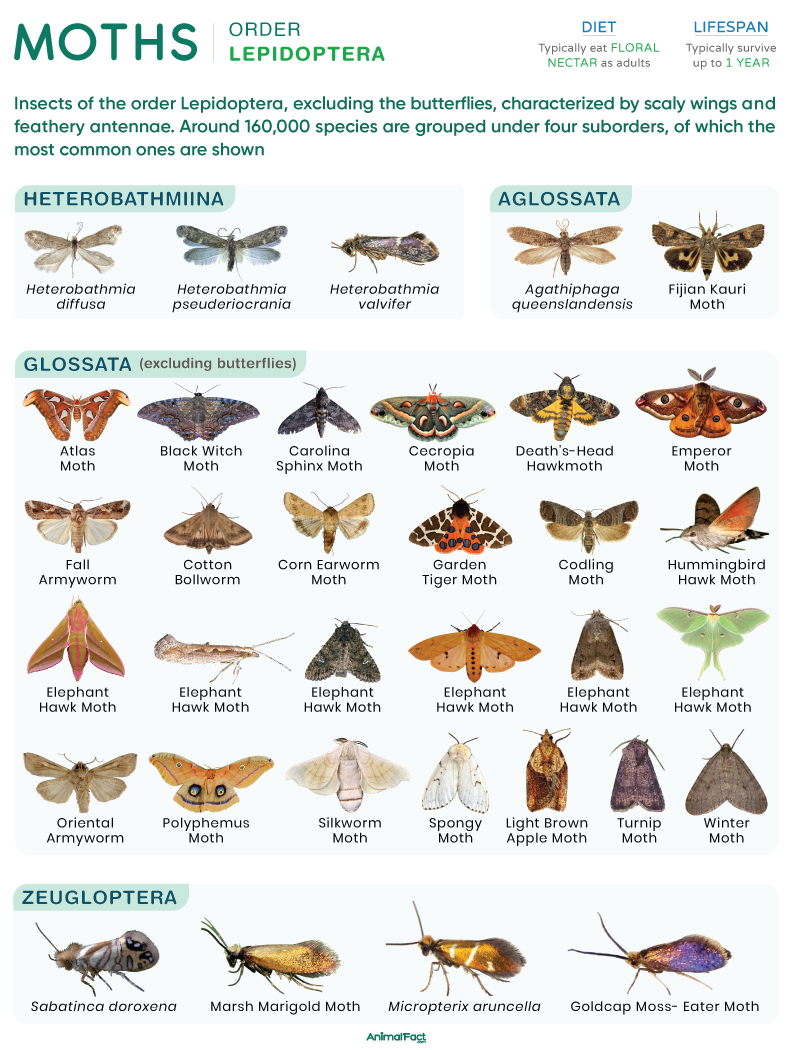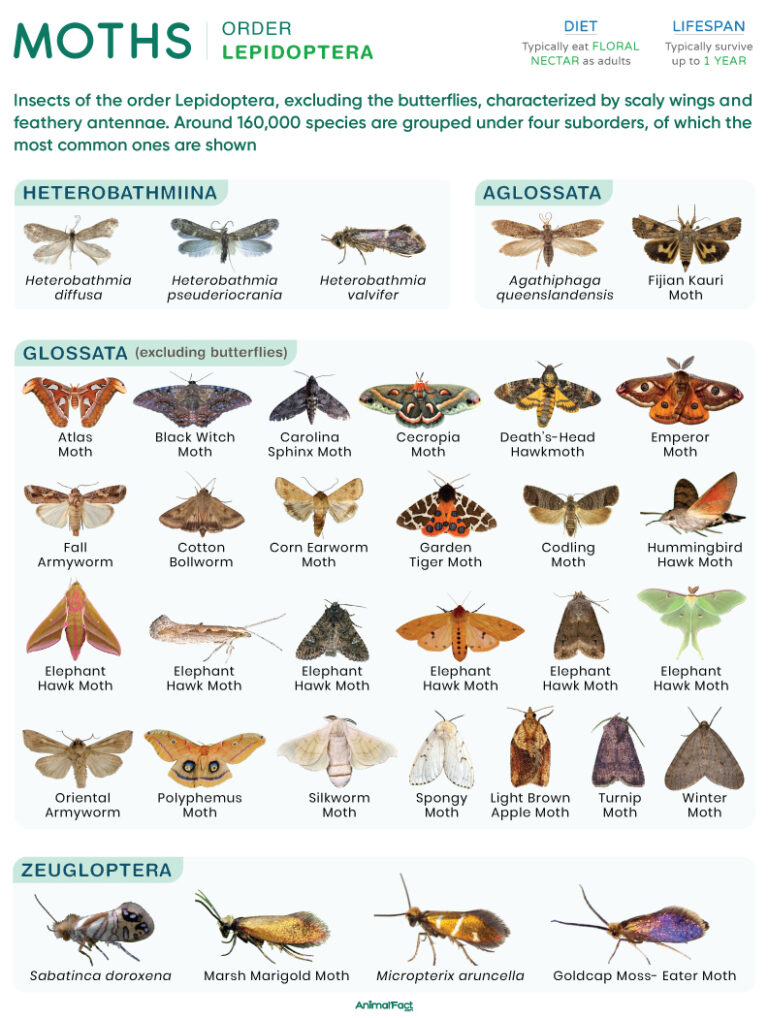


Moths are insects classified under the order Lepidoptera, including all members of the group except butterflies. They are typically distinguished from butterflies by their antennae, which are feathery or filamentous rather than clubbed. However, both moths and butterflies have scales on their forewings and hindwings, which confer their body coloration.

Like butterflies, moths are holometabolous insects that undergo complete metamorphosis through four distinct stages: egg, larva (caterpillar), pupa, and adult. As adults, most species feed primarily on floral nectar, which they extract using an elongated, straw-like mouthpart, the proboscis.
There are around 160,000 species of moths having a nearly cosmopolitan distribution. While many species are pests that inflict damage to crops, as well as fabric, others are economically important for the silk they produce in their larval stage. They are generally harmless to humans since they cannot bite.
One of the largest moths, the Atlas moth (Attacus atlas), has a wingspan of up to 9.4 in (240 mm), whereas the pygmy sorrel moth (Enteucha acetosae), one of the smallest, has a wingspan of only around 0.1 in (3 mm).[1][2]
Like butterflies, moths have a bilaterally symmetrical body divided into three broad segments: head, thorax, and abdomen. Their bodies are covered with the hard, chitinous exoskeleton characteristic of all arthropods.
The head bears a pair of antennae, a pair of compound eyes, and a coiled, straw-like proboscis adapted for sucking nectar or other fluids.
Unlike butterflies, which have antennae with clubbed tips, moths typically have feathery or threadlike antennae without clubs.
The thoracic region is subdivided into the pro-, meso, and metathorax, each bearing a pair of legs. The mesothorax and metathorax bear the forewings and the hindwings, as well as two pairs of spiracles (openings) for respiration. Like butterflies, the wings of moths are typically covered in scales that give them their color. Although most species have dull-colored wings, a few, such as the Madagascan sunset moth (Chrysiridia rhipheus), have vibrant combinations of black, green, blue, turquoise, red, orange, and yellow.
When at rest, moths either fold their wings over the body, wrap them around the body, or extend them at their sides, unlike butterflies that hold their wings vertically.
The abdominal region, typically with 10 visible segments, bears the digestive, respiratory, and reproductive organs. The first eight segments bear paired spiracles.
In males, the abdomen ends in a pair of claspers that are used to grasp the female during mating. They also have an intromittent organ, the aedeagus, which helps transfer sperm to the females.
The posterior tip of the abdomen in females bears a tube-like organ, the ovipositor, that they use to lay eggs on host plants. They also possess a specialized sac-like structure called the spermatheca for storing the sperm they receive from the males during mating.
All species are classified into 4 suborders.
Moths are believed to have appeared before butterflies, with their fossils dating back to around 190 million years ago.
Moths are found worldwide except in Antarctica. One species, the Indian meal moth (Plodia interpunctella), was spotted at the Chilean Yelcho research station on Doumer Island, located near the west coast of the Antarctic Peninsula. However, it is an introduced species, accidentally transported by humans.[3]
These insects inhabit a wide variety of habitats, including forests, grasslands, deserts, and agricultural lands. They are also found in urban and suburban areas, particularly near artificial sources of light.
Most adult moths feed on liquids, particularly nectar from flowers, though a few species may supplement their diet with tree sap and juices from ripening or fermenting fruits. They also obtain moisture from mud, wet sand, or other damp substrate. A few species, such as the luna moth (Actias luna), have vestigial mouthparts, and they rely solely on the energy stored during their caterpillar stage.[4]
Caterpillars typically feed on plant parts, such as leaves, stems, flowers, or fruits. Those of most species of the family Tineidae (fungus moths) consume fungi, lichens, and detritus. However, the common clothes moth (Tineola bisselliella), also a fungus moth, typically feeds on natural fibers, such as wool.[5]
Most moths are active at night (nocturnal), and they are attracted to artificial lights (positive phototaxis). During feeding, they uncoil the proboscis and suck up nectar or tree sap from the source. A few vampire moths (Calyptra) can pierce the skin of their host with their proboscis and suck their blood.
While feeding on nectar, these insects end up transferring pollen grains. In fact, species from the families Erebidae and Sphingidae are considered key pollinators for certain flowering plants in the Himalayan ecosystem.
The lifespan of moths varies with species. For instance, adult silkworms (Bombyx mori) typically live for 3 to 5 days, whereas the Death’s-head Hawkmoth (Acherontia atropos) has a lifespan of about 6 weeks.
The larval stage of the Arctic woolly bear moth (Gynaephora groenlandica) can last up to 7 years, the longest known for any moth.[6]
Most moths reproduce sexually, typically during spring or summer, with the males being guided by the females through pheromones. After mating, the females lay eggs on suitable host plants either singly or in clusters. Depending on the species, they may lay a few dozen to thousands of eggs.
Within 4 to 10 days, the eggs hatch into larvae or caterpillars. These larvae feed on plant tissue, molting 4 to 6 times to become pupae. Many species, such as silkworms, spin a silk cocoon, while others pupate in soil or leaf litter. Within the pupa, the larval tissue gets restructured to form adult structures like wings and reproductive organs.
At maturity, the adult moth emerges by splitting the pupal case and expanding its wings.
Since most moths are nocturnal, one of their primary predators is bats. They also become targets of nocturnal and crepuscular birds (like nightjars and owls). Day-flying moths fall prey to flycatchers, swallows, and other insectivorous birds.